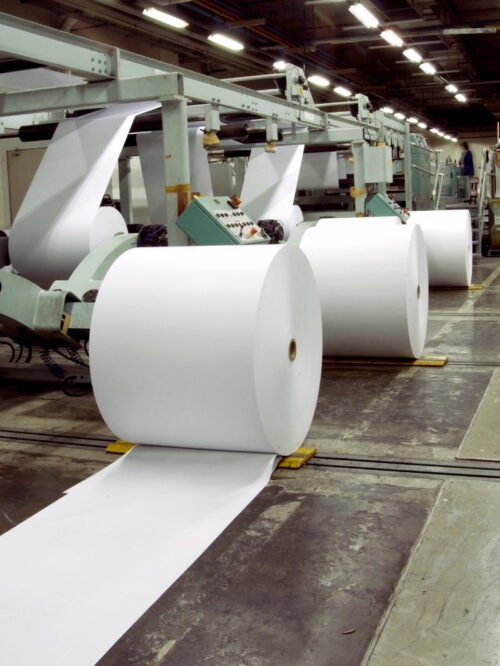Supply chain woes have been a frequent refrain since the COVID pandemic began. In the paper and print industries, decreased production, supply chain snafus, and rising costs have translated to challenges for URI alumni—and URI’s alumni magazine.
By Lawrence Goodman
It’s not the kind of event that John Palumbo ’76, publisher of Rhode Island Monthly Communications, typically attends when he goes to industry conferences—a panel on the paper industry.
Sure, every so often, a company introduces a new weight, page size, or finish, but for the most part, there are not a lot of changes. Paper is, well, paper.
But at the City and Regional Magazine Association meeting in the fall of 2021, Palumbo heard that the “Print, Paper and Circulation Roundtable” shouldn’t be missed.

What he heard, he says, “sent him into an all-out panic.” He returned to Providence and immediately began to look for cost savings.
These are rough and difficult times for the paper industry. Dire shortages in paper have led to price spikes as high as 40 percent compared to only a year ago. Magazines are printing on cheaper stock, reducing pages, and dropping subscribers to save on printing costs.
With budgets typically much lower than commercial publications, alumni magazines are particularly hard hit. The University of Rhode Island Magazine is sending out only one print edition this year—its fall issue. The spring and summer issues were online-only.
Other industries that rely heavily on paper, such as commercial printers and book and catalog publishers, are also struggling. State election officials worry there won’t be enough paper to print voter pamphlets and ballots. There are even now fears of another round of paper towel and toilet paper shortages.
“It’s a real mess,” says Barbara Caron, URI Magazine editor-in-chief. “It’s made planning very difficult. I am hearing from other alumni magazine editors that, like us, they’ve had to cancel print issues. And even for those who go to print, it’s not unusual to get a call from the printer just before an issue goes to press, saying, ‘We have 70 percent of the paper you need; you have to cut pages or cut your mailing list.’ And they have days to make the decision and execute it. These are huge challenges resulting from unprecedented paper supply shortages and cost increases.”
How did this happen?
Kevin Sheahan ’89 is the third generation in his family to work in the printing business. He and his brother David run Sheahan Printing in Woonsocket, R.I, producing catalogs, brochures, direct mail, annual reports, and newsletters.
Sheahan says the print industry’s woes are due to a “perfect storm” of factors.
For starters, domestic paper production decreased for several years before COVID, the result of consolidation in the industry and buyers searching abroad for lower prices. Many domestic paper mills outright closed.
But all of this happened steadily enough, with the market adjusting accordingly, that prices remained stable. There was always enough supply to meet demand, according to Sheahan. “If there was a shortage,” he says, “it was in the amount of work we got, but never for paper.”
Then in early 2020, COVID-19 struck. People were stuck in their homes or feared going out, resulting in a huge drop in retail shopping and a spike in online ordering. Mills adapted by shutting down paper production and manufacturing cardboard and other packaging materials needed for shipping. This trend had been going on for years but now greatly accelerated. Bloomberg News reported that by 2021, there was a 20 percent drop in printing and writing paper capacity at North American paper mills.
When the economy started to recover in late 2020, demands for paper returned to pre-pandemic levels. But now, there wasn’t enough supply to meet demand. Before COVID, foreign suppliers might have been able to step in. But like many international industries, their supply chains were now bedeviled with snafus and setbacks such as shipping delays and backups at ports.
Sheahan says that in the past, his paper orders were typically fulfilled within 24 hours. This year, it can take as long as two months to receive an order, and that’s if the paper is available. “Inventory is either low or nonexistent,” Sheahan says. “It’s a daily struggle to find the paper we need for projects.”
According to URI College of Business associate professor of supply chain management Yuwen Chen, the paper industry’s woes are also due to some of the same factors driving inflation and goods shortages in other sectors of the economy.

He says a shortage of truck drivers to deliver stock and rising fuel prices due to the war in Ukraine have raised transportation costs significantly. The rail industry also adjusted freight train schedules and utilization during the pandemic and has had difficulty restoring service to normal now that the economy is returning to full strength.
Chen says the pandemic has exposed the fragility of the supply chains American companies rely on to produce and deliver goods to consumers. He says for years, experts warned that businesses’ supply chains were too complicated and spread out across the globe. If one link in the chain broke, they said, it could have a cascading effect and disrupt the entire system.
Chen says these warnings went unheeded, and it’s now difficult for the American economy to return to normal. “You have to face the reality that you cannot easily fix this problem since all elements in the supply chain are interconnected,” Chen says.
For the time being, businesses are coping the best they can.
Palumbo says his company, which, in addition to publishing Rhode Island Monthly magazine, also publishes bridal and home design magazines and other custom publications, is looking for cost savings by limiting the page count of its publications or even moving some of them online only.
He says the paper shortage is also putting a strain on his efforts to grow the company and find new customers for the custom publishing side of his business. His printer recently told him that he can only handle Palumbo’s existing orders and doesn’t have access to enough paper to print publications from any potential new publishing projects.
“In my 25 years in the business, I’ve never had a printer tell me he doesn’t want new business,” Palumbo says.
Sheahan, for his part, has informed his customers of the paper shortages and asks that they place orders a month or two in advance. When certain paper types are unavailable—often for inexplicable reasons—he suggests his clients use another type that he can secure more readily.
Still, Sheahan worries that some companies may switch permanently to digital communications. As he sees it, this would ultimately be a counterproductive decision. “I believe that print is still one of the best ways to communicate your message,” he says.
Sheahan says he expects the current crisis to end by early 2023, a view shared by Palumbo and other industry experts. “This is an unprecedented situation in my 33 years in the business,” Sheahan says, “but I have no choice. I’m staying cautiously optimistic.”

Mr. Palumbo:
I’m the Associate Director of Print Purchasing for one of the largest direct mail companies in the US. We buy tons of paper and have been dealing with this shortage since June of 2021. I feel your pain. Your greatest asset right now is your relationship with suppliers. Your readers don’t care what kind of paper you print on, as long as it’s presentable. And they won’t notice a small size change as long as your content is the same. Unless you have a contract, branch out to other suppliers and tweak your formats to fit the paper and presses available. Some grades are slightly easier, or shall I say less difficult, to come by. Extend your lead times by several months not several weeks if you’re able.
This crisis is not expected to stabilize until well into 2023. Demand may slow down with a looming recession however supply will continue to be a challenge due to ongoing supply chain issues. Get a subscription to Printing Impressions if you don’t already have one and keep an eye out for new vendors that you may be able to align yourself with. My daughter just graduated from URI in May and I keep telling her (half heartedly) ‘Don’t get into the printing business!’ The best of luck to you.
Has the letters to the editor section been discontinued?
Thank you for your question, Charles. No, it has not been discontinued. A selection of letters to the editor appear in the Feedback section of each print issue. The next print issue (fall 2022) will include letters from readers.